Introduction
XPEL, Inc. (NASDAQ:XPEL) has been gaining popularity and outperforming the rest of the film market with its flagship products, achieving a revenue CAGR of approximately 65.14%. However, there are risks to consider, such as competition from new entrants and incumbents, and a decreasing ROIC. While XPEL’s shares seem slightly undervalued, the current price doesn’t offer enough margin of safety, so we recommend a ‘Hold’ position.
Competitive Landscape
The principal markets where XPEL competes are the paint protective paint market and the window tint market. In the second one, its flagship product is less known than in the PPF market, but it’s been gaining popularity, as can be seen in the annual growth of the segment:
Author’s Elaboration with data from XPEL Annual Reports
With a CAGR of approximately 65.14%, XPEL revenue in this market has outperformed the rest of the market, as the window film industry is growing at a CAGR of 4.2% in the US. In this sense, the three most-known brands in the automotive window tint are 3M (MMM), Llumar, and Hüper Optik. When comparing XPEL with 3M, it’s clear that XPEL PRIME XR PLUS (the flagship product) is competitive, as it has even better features (for instance, it has better sun glare reduction and solar energy rejection) than 3M with lower prices. Thus, I think XPEL entered the window market with an appealing proposition, which helped it gain market share quickly and increase brand awareness. Furthermore, knowing the quality of its automotive window film, I believe it’s safe to say we can expect the same quality in the architectural window market. The latter might be confirmed by the high demand for XPEL products in this market, which is reflected by the high double-digit revenue growth rate. Consequently, I expect high growth in the coming years as XPEL continues to take market share from other companies with low-quality products.
Regarding the PPF market, there are two main competitors, 3M and Eastman Chemical Company (EMN). In this market, XPEL has attained a unique position by caring for its brand reputation. First, the firm garnered a loyal customer base by bringing innovative products to the market (for instance, it introduced the first self-healing film) and offering quality film. Second, XPEL carefully selects the installers of its products, as a bad installation can completely ruin the customer’s experience and destroy the brand’s reputation.
Moreover, XPEL not only creates value for its final customer but also for the installer by developing its DAP software, which is continuously updated to accelerate the installation of PPF and reduce waste, and by integrating its installer in its websites, which increases customers’ trust.
Furthermore, XPEL has focused uniquely on the film industry, unlike its principal competitors, which are chemical giant companies, so PPF and window films represent only a portion of total sales. Therefore, XPEL has grown its sales at an accelerated rate thanks to strong demand for its products and by acquiring companies in the market (integrating vertically by acquiring installers and migrating to services). In this sense, I think the company has raised mid-high barriers to entry by applying a focus strategy in the film market, which develops a strong brand, a broad installer network in which installers enjoy DAP software and reputational advantage by being Authorized Dealer, and a weak know-how as the principal chemical companies focus on other larger markets. Consequently, I believe XPEL will remain competitive and that there is a high probability of XPEL maintaining its high return on invested capital.
Nonetheless, the weak know-how can be surpassed by other companies, such as Tesla, which announced it would start offering its own wrap, causing XPEL shares to plummet. The company reported that 5% of its sales come from Tesla vehicles. However, even if it is a small percentage when the company is growing at a double-digit rate, it’s also a warning sign, as the company will probably lose a significant portion of the future sales related to Tesla vehicles, impairing future growth opportunities as Tesla is the automaker with the highest growth. Nevertheless, I think it is unlikely that other automakers will begin to offer their wraps or films, as it requires new investments and the development of high-quality products that are going to compete with established brands such as 3M, Llumar, XPEL, and Suntek; thus, the risk is high. Even so, it’s clear that other companies could enter the market and challenge XPEL’s position as the returns seem high enough to be attractive; however, I consider XPEL to have the competitive advantages to defend its position.
Finally, XPEL is diversifying geographically, and seeing its growth rates in all the locations, its products have a high degree of acceptance. The company is investing in its Service Segment by acquiring installers, which could deteriorate its relationships with other installers as they become competitors. Additionally, in its last earnings call, the management estimated that the PPF market has only penetrated 15% of the new car sales. They believe the market can increase to 75% (which they estimated to be the largest market size), so even in XPEL’s largest market (the U.S.), revenue could double in the following years thanks to changes in the industry channels. For instance, as more dealerships and OEMs offer PPF, PPF product awareness increases, driving new people to purchase it for its new vehicles.
Furthermore, management believes the cannibalization among channels will be low, if any, due to current customers preferring to install PPF in the aftermarket. In contrast, the new customers will likely come from dealership and OEM channels. Knowing the former, XPEL dominates an industry with a significant upward potential as the penetration rate (in the US and the rest of the world) increases. However, new entrants could jeopardize the future performance as the industry shows attractive returns. For instance, Tesla developed its color wraps, and Entrotech (XPEL’s supplier) allied with PPG to create color wraps.
Financial Performance
XPEL’s competitive advantages are reflected in its outstanding financial performance. First, revenue has grown at a double-digit rate since 2018, with 2019 being the only year with a revenue growth rate lower than 20%.
Author’s Elaboration with data from SA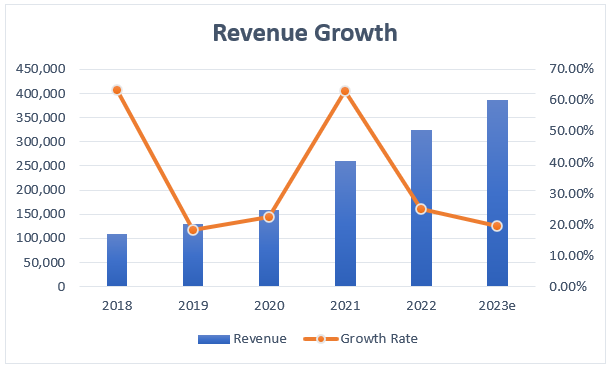
Knowing that 65% of sales come from installers and dealerships, its high growth rates gain more relevance as the sales of new vehicles in the US have been flat since the recovery in 2020 and lower respect to prepandemic levels. Moreover, seeing Eastman Chemical’s annual reports, its Performance Film segment has grown from approximately $604.4 million in 2020 to $641.4 million; hence, XPEL has been hoarding more market share in the industry, and I think it could continue that way as Eastman Chemical focuses on other projects, such as the methanolysis plastic-to-plastic molecular recycling manufacturing facility. Nevertheless, revenue has been affected by the general slowdown in the Chinese economy due to COVID-19 restrictions and a softer-than-expected recovery, so China is the only region where the company has experienced decreasing revenue since 2022. In this regard, Tesla’s entrance into the industry will impair future sales growth.
FRED 2022 XPEL 10K Report 3Q23 XPEL 10Q Report


Furthermore, lately, the company has been investing aggressively in the Service Segment, causing a rapid increase in revenue.
Author’s Elaboration with data from XPEL Annual Reports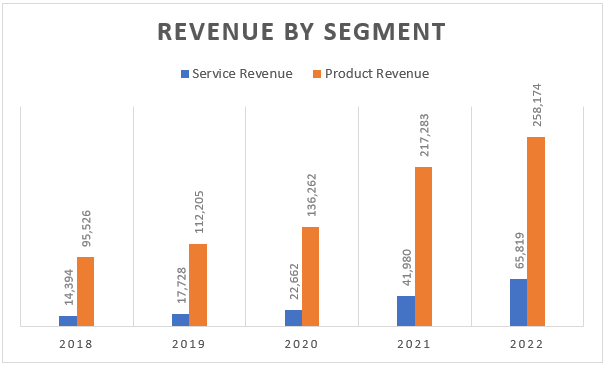
In this sense, the gross margin has been increasing thanks to higher margin revenue from the Service Segment. However, in the last five years, the Product Service gross margin increased thanks to a higher operating leverage, improvement in product costs, and decreasing revenue to China (which carries lower margins). In the last nine months, the gross margin improved from 34.4% to 37.4%, which is impressive given the higher interest rates, a slowdown in demand, and the discretionary nature of XPEL products.
Author’s Elaboration with data from XPEL Annual Report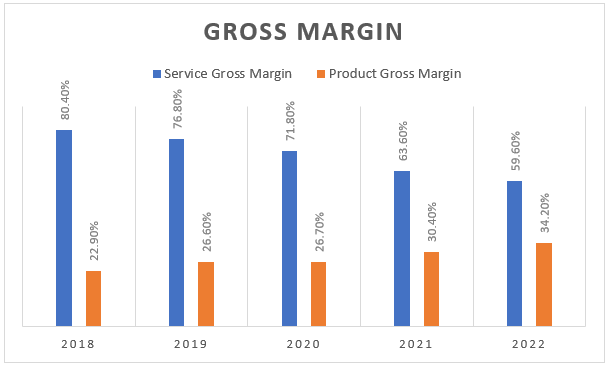
Even if it carries a higher gross margin, the Service Segment’s margins have decreased since 2018 as the labor-intensive installation service has increased its size in the product mix. Nonetheless, it still has higher margins, so I expect an improvement in profitability in the following years as the Service Segment increases in size relative to the Product Segment.
Lastly, ROIC has been decreasing since 2019, which I believe is the result of diversifying into new adjacent markets by product development and acquisitions. Hence, XPEL may be paying too much for some of its acquisitions, causing a deterioration in ROIC, and even if the ROIC remains high, the management expects to keep destining all the excess cash flow to acquisitions and market expansions, so it could be reasonable to expect a lower ROIC than in the previous years. However, the company has plenty of opportunity to keep growing, and if it can hold a ROIC higher than 15% (which I think is plausible), I believe investors can earn an appealing return on their investment. Moreover, as the company repaid its line of credit, the financial risk is minimal, and the management may have more cash available (due to lower interest payments and the ability to issue new debt) to pursue further acquisitions.
Author’s Elaboration with data from QuickFS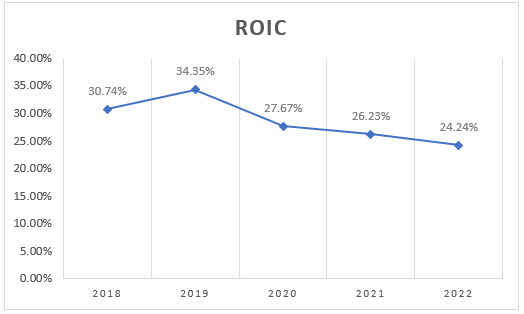
Risk
Competition
As we saw, XPEL has built a unique brand awareness in the industry, consolidating as the leader. However, new entrants and incumbents may try to take a piece of the cake, given the high returns exhibited by XPEL in the last five years.
Management Changes
From my perspective, the management has done an outstanding job if we measure its success with financial performance. The company is growing with high returns on investment, has a dominant market position, and a healthy balance sheet. Furthermore, the CEO and Chairman, Pape Ryan, has around 4.05% of the total shares outstanding, so it holds a $51.71 million interest in the company. In this sense, two directors, Adams Mark and Crumly Richard, own approximately 13.03% of the company.
Nevertheless, some changes have occurred in the management team, as the former vice president of sales and products, Matthieu Moreau, resigned, and two new members, Tony Rimas and Kim Steiner, were added to the management team. Tony Rimas is the new VP of Revenue and has broad experience in the automotive industry, especially running dealership locations and automotive venture capitals. Kim Steiner is the VP of People and Culture. Checking on the companies where she served as a talent manager, both have better reviews on Glassdoor than XPEL; thus, we may see an improvement in the XPEL culture. However, changes add uncertainty to future returns and probabilities of success.
Economic Conditions
XPEL’s business relies highly on the automotive industry’s health, which is significantly dependent on general economic conditions. The US automotive industry has remained strong even in an environment of higher interest rates and low consumer confidence. Nevertheless, the general slowdown of the economy, along with a possible recession, may decrease new vehicle sales, affecting XPEL sales.
China Market
The Chinese market, the third largest XPEL market, brings some serious risks related to doing business in China, such as high economic and political uncertainty, trade restrictions, controlled FX markets, and ambiguous laws.
Foreign Currencies
As the company expands to international markets, the risk of a stronger dollar increases and threats to decrease revenue in some periods. However, the US is the largest market by revenue, so the effects of exchange rates (unless they come from the Canadian Dollar or Renminbi) will be negligible for now.
Valuation
For my DCF model, I will assume that revenue in 2023 will be $387.39 million and will be composed of $81.828 million from the Service Segment and the rest from the Product Segment. Revenue from the Service Segment will grow at a CAGR of 24%, whereas revenue from the Product Segment will grow at a CAGR of 16%. Therefore, the whole revenue growth rate will be over 17%, which is conservative compared to the previous revenue growth and the significant opportunities of the industry. Moreover, the gross margins from the Service Segment and the Product Segment will be 55% and 37%, both values slightly lower than the gross margins recorded in the last nine months. Finally, the discount rate will be 15.5%, and the terminal value will be a P/FCF of 18, expecting multiple compression.
Author’s Elaboration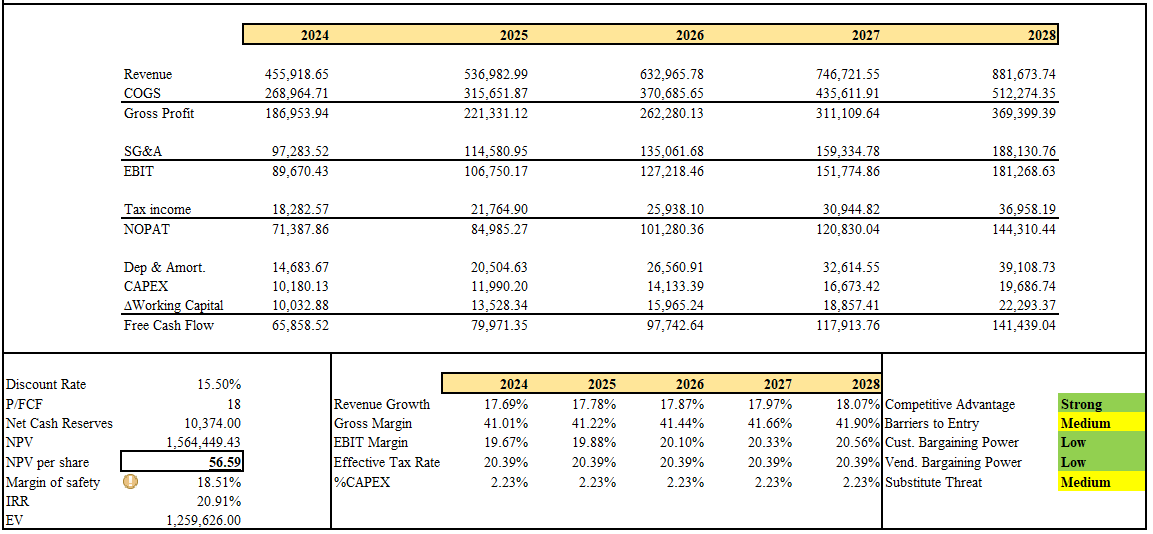
Consequently, given the premises, XPEL shares seem to be slightly undervalued after they plummeted due to Tesla news. Nevertheless, the current price doesn’t offer enough margin of safety, so I recommend a ‘Hold’ position.
Conclusion
In conclusion, XPEL has shown impressive financial performance, with high returns on investment, a dominant market position, and a healthy balance sheet. However, there are risks, such as competition from new entrants and incumbents. While XPEL’s shares seem slightly undervalued, the current price doesn’t offer enough margin of safety, so we recommend a ‘Hold’ position. Overall, XPEL’s competitive landscape in the paint protective film and window tint markets is robust and has significant growth potential.
Read the full article here


